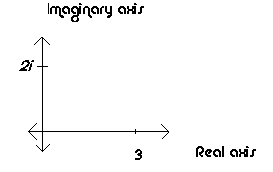
Imaginary numbers were invented to help us deal with the square root of negative numbers which don't exist It is a technique that is useful in mathematical calculations. For example, √-1 is called i. No real number can be squared to result in a negative number. Conversely, you cannot get the square root of a negative number and get a real number.
So i = √-1 or i2 = - 1
A complex number results when we combine a real number with an imaginary number by addition or subtraction.
Complex Number = ( Real Part) + ( Imaginary Part) i
z = a + bi or z = a - bi
The letter z is normally used to denote a complex number, a is called the real part and b is called the imaginary part.
An Argand diagram is used to plot complex numbers. It is similar to the x and y axis in coordinate geometry. The difference being the horizontal line is called the real axis and the vertical axis is called the imaginary axis.

Different types of transforms on the Argand diagram:
|
Axial symmetry in the real axis |
|
|
Axial Symmetry in the imaginary axis |
|
|
Central symmetry through the origin. |
Relevance?
Computers cannot make the distinction between a real or an imaginary images so it uses a operation called the Fourier transform to get over this problem. You take an image and put it through the Fourier transform system and by getting the magnitude it can transform the image. Discrete Fourier transform is important to many kinds of signal processing the analysis and compression of video and sound information.
Below is an image that has been put through the forward and reverse Fourier transform.
